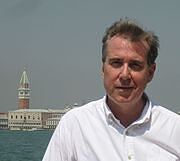Thomas F. Madden
Author of The New Concise History of the Crusades
About the Author
Thomas F. Madden is professor of history and director of the Center for Medieval and Renaissance Studies at Saint Louis University.
Works by Thomas F. Madden
Empires of Trust: How Rome Built—and America is Building—a New World (2008) — Author — 126 copies, 3 reviews
The Concise History of the Crusades (Critical Issues in World and International History) (2013) 85 copies
Sword and Cross: Medieval Europe's Crusades Against the Armies of the Levant (2005) 18 copies, 2 reviews
The Medieval World I: Kingdoms, Empires, and War, 7 Cds [Complete & Unabridged Audio Work] (2009) 13 copies, 1 review
The Modern Scholar: The Medieval World, Part II: Society, Economy, and Culture (The Modern Scholar) (2009) 8 copies
The Modern Scholar: Christianity At the Crossroads: The Reformations of the Sixteenth and Seventeenth Centuries (2007) 7 copies
The Modern Scholar: The Lost Warriors of God: The True History of the Knights Templar (2014) 5 copies
Father of the Bride: Fathers, Daughters, and Dowries in Late Medieval and Early Renaissance Venice 2 copies
The Coming of the Friars 1 copy
The Rise of the Universities 1 copy
Heresy and Inquisition 1 copy
The Rise of Islam 1 copy
Monasticism 1 copy
The Reformation 1 copy
Daily Life and the Family 1 copy
Gothic Architecture 1 copy
The Carolingian Renaissance 1 copy
The Modern Scholar: One Holy Catholic and Apostolic: A History of the Church in the Middle Ages 1 copy
The Hundred Years War 1 copy
Christianity Triumphant 1 copy
Monks and Monasteries 1 copy
Tagged
Common Knowledge
- Birthdate
- 1960-06-10
- Gender
- male
- Nationality
- USA
Members
Reviews
Lists
Awards
You May Also Like
Associated Authors
Statistics
- Works
- 67
- Members
- 1,839
- Popularity
- #13,999
- Rating
- 3.9
- Reviews
- 43
- ISBNs
- 142
- Languages
- 7
- Favorited
- 4














Octavian was Caesar's grand-nephew, not his nephew.
The word "diocese" does not come from "Diocletian".
The point about why Diocletian made the office of Emperor more revered and remote is kind of not made clearly.
And on and on. It becomes really difficult to know when you can trust what is said.
Plus where is the academic underpinning? We're told at the start that it's important because maybe our civilization will also fall someday. But then over the course of several centuries and even at the end this point is never picked up again. Really it's mostly just guilty pleasure of recounting a bunch of old stories.… (more)